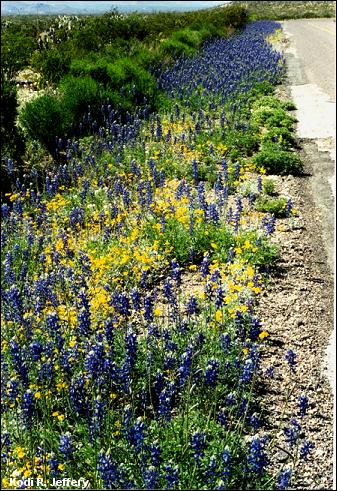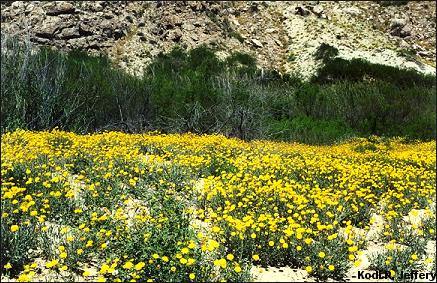

Every spring the news media, magazines, and environmental groups laud the desert as it bursts forth into blossoms of every color—but have you ever seen this up close and in person? Those who traveled to the Big Bend during the peak of bloom this year were rewarded with a bumper crop of bluebonnets, desert marigolds, yuccas and more! When the Mexican Gold Poppies on the east side of the Franklin Mountains pop forth, we marvel at their beauty and take note of spectacular years.
But why are the displays more glorious some years than others? The most
crucial factor may be heavy autumn rains to break down the seed's chemical
inhibitors, followed by winter moisture to sustain germination. Seeds can lie dormant
for 20, 40, even 60 years, waiting for the perfect conditions. Imagine how all this
affects the pollinators. Surely they must be delighted—and overwhelmed—at such a
plethora of dining options. Perhaps it's good such a glorious display only happens
occasionally—without periods of poverty, who would appreciate wealth?

Listen to the Audio (mp3 format) as recorded by KTEP, Public Radio for the Southwest.
Contributor: Kodi R. Jeffery, Centennial Museum, University of Texas at El Paso.
Desert Diary is a joint production of the Centennial Museum and KTEP National Public Radio at the University of Texas at El Paso.

Bluebonnets and other roadside wildflowers, Big Bend, Texas, 17-18 March 2001. Photograph by Kodi R. Jeffery.

Desert Marigolds in the Big Bend, Texas, 17-18 March 2001. Photograph by Kodi R. Jeffery.
Warnock, B. H. 1970. Wildflowers of the Big Bend Country, Texas. Sul Ross State University Press, 1970.